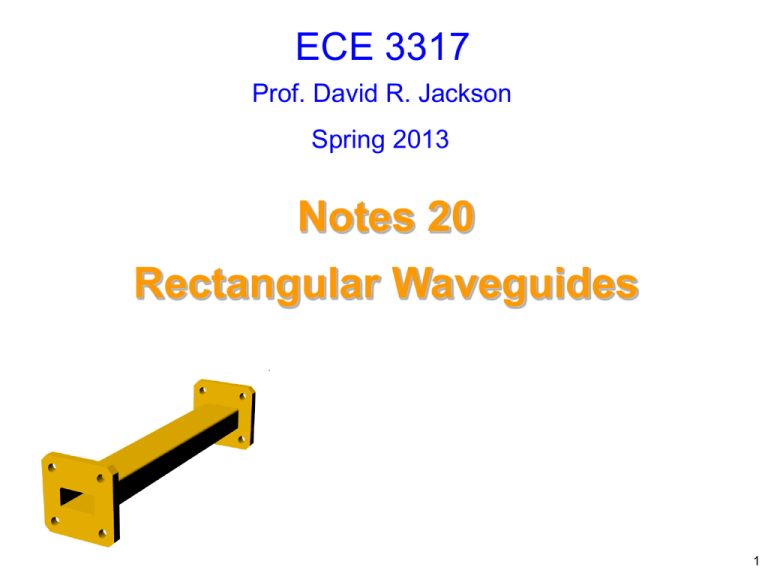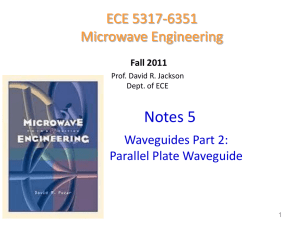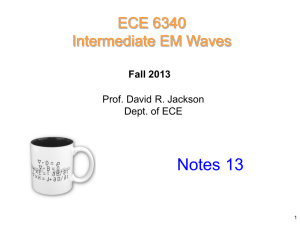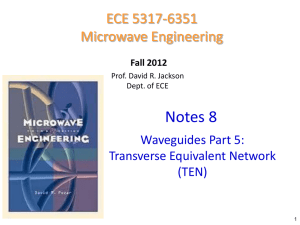notes 20 3317
advertisement

ECE 3317 Prof. David R. Jackson Spring 2013 Notes 20 Rectangular Waveguides 1 Rectangular Waveguide Rectangular Waveguide y b , x a Cross section We assume that the boundary is a perfect electric conductor (PEC). We analyze the problem to solve for Ez or Hz (all other fields come from these). TMz: Ez only TEz: Hz only 2 TMz Modes TMz H z 0, E z 0 2Ez k 2Ez 0 (Helmholtz equation) E z 0 on boundary Guided-wave assumption: (PEC walls) Ez x, y, z Ez 0 x, y e jkz z 2E z 2E z 2E z 2 2 2 y z x 2 k Ez 0 2E z 2E z 2 2 2 2 kz E z k E z 0 y x 3 TMz Modes (cont.) 2E z 2E z 2 2 k k z Ez 0 2 2 x y Define: We then have: kc2 k 2 kz2 2E z 2E z 2 k c Ez 0 2 2 x y Dividing by the exp(-jkz z) term, we have: Note that kc is an unknown at this point. 2E z 0 2E z 0 2 k c Ez0 0 2 2 x y We solve the above equation by using the method of separation of variables. We assume: Ez 0 x, y X x Y y 4 TMz Modes (cont.) 2E z 0 2E z 0 2 k c Ez0 0 2 2 x y where Ez 0 x, y X x Y y Hence, X Y XY kc2 XY Divide by XY : X Y kc2 X Y Hence This has the form X Y 2 kc X Y F x G y Both sides of the equation must be a constant! 5 TMz Modes (cont.) X Y 2 kc constant X Y Denote X k x2 constant X General solution: Boundary conditions: X ( x) Asin(kx x) B cos(kx x) X (0) 0 (1) X (a ) 0 (2) (1) (2) B 0 X ( x) Asin(kx x) sin(kx a) 0 6 TMz Modes (cont.) The second boundary condition results in sin(kx a) 0 This gives us the following result: kx a m , m 1, 2 kx Hence m a m x X ( x) A sin a Now we turn our attention to the Y (y) function. 7 TMz Modes (cont.) We have X Y 2 kc k x2 X Y Hence Y k x2 kc2 Y Denote k y2 kc2 kx2 Then we have General solution: Y k y2 Y Y ( y) C sin(k y y) D cos(k y y) 8 TMz Modes (cont.) Y ( y) C sin(k y y) D cos(k y y) Boundary conditions: Y (0) 0 (3) Y (b) 0 (4) (3) (4) D0 Y ( y) C sin(k y y) sin(k yb) 0 Equation (4) gives us the following result: k yb n , n 1, 2 ky n b 9 TMz Modes (cont.) Hence n y Y ( y) C sin b Therefore, we have m x n y E z 0 x, y X x Y ( y) AC sin sin a b New notation: m x n y E z 0 x, y Amn sin sin a b The TMz field inside the waveguide thus has the following form: m x n y jkz m ,n z E z x, y, z Amn sin sin e a b 10 TMz Modes (cont.) Recall that k y2 kc2 kx2 kc2 kx2 k y2 Hence Therefore the solution for kc is given by m n k a b 2 2 2 c Next, recall that Hence kc2 k 2 kz2 kz2 k 2 kc2 11 TMz Modes (cont.) Summary of TMz Solution for (m,n) Mode (Hz = 0) m x n y jkz m ,n z E z x, y, z Amn sin sin e a b m,n kz m n k2 a b 2 2 m 1, 2, n 1, 2, Note: If either m or n is zero, the entire field is zero. 12 TMz Modes (cont.) Cutoff frequency We start with k z m ,n k 2 kc m ,n where Set kz m, n 0 kc m,n m n a b 2 k kc Note: The number kc is the value of k for which the wavenumber kz is zero. 2 2 m, n kc m,n 2 f kc m,n 13 TMz Modes (cont.) 2 f kc Hence m,n m n 2 f a b 2 which gives us 2 The cutoff frequency fc of the TMm,n mode is then TM m ,n fc 1 2 m n a b 2 2 This may be written as c m n d 2 a b 2 f TM m ,n c 2 cd 1 14 TEz Modes TEz E z 0, H z 0 We now start with 2H z 2H z 2 2 k k z Hz 0 2 2 x y Using the separation of variables method again, we have Hz 0 x, y X x Y y where X ( x) Asin(kx x) B cos(kx x) Y ( y) C sin(k y y) D cos(k y y) and kc2 kx2 k y2 kz2 k 2 kc2 15 TEz Modes (cont.) y Boundary conditions: E x ( x, 0) 0 E y (0, y ) 0 E x ( x, b) 0 E y ( a, y ) 0 b , x a The result is cross section m x n y H z 0 x, y Amn cos cos a b This can be shown by using the following equations: j H z jk z Ez Ex 2 2 2 2 k k y k k z z x H z 0, y y 0, b j H z jk z Ez Ey 2 2 2 2 k k x k k z z y H z 0, x x 0, a 16 TEz Modes (cont.) Summary of TEz Solution for (m,n) Mode (Ez = 0) m x n y jkz m ,n z H z x, y, z Amn cos cos e a b k z m,n m n k2 a b 2 m 0,1, 2 n 0,1, 2 2 Same formula for cutoff frequency as the TEz case! m, n 0,0 Note: The (0,0) TEz mode is not valid, since it violates the magnetic Gauss law: H x, y, z zˆ A00 e jkz H x, y, z 0 17 Summary TMz m x n y jkz m ,n z E z x, y, z Amn sin sin e a b TEz m x n y jkz m ,n z H z x, y, z Amn cos cos e a b k z m,n m n k2 a b m,n fc TMz 2 c d 2 m n a b 2 m 1, 2, n 1, 2, TEz 2 Same formula for both cases 2 Same formula for both cases m 0,1, 2, n 0,1, 2, m, n 0, 0 18 Wavenumber General formula for the wavenumber m n kc a b 2 TMz or TEz mode: k z k 2 kc2 with 2 Note: The (m,n) notation is suppressed here. Above cutoff: k z k 1 kc / k 2 k 1 c / k 1 fc / f Hence Recall: k 2 kc c 2 kz k 1 fc / f 2 c fc d 2 m n a b 2 2 19 Wavenumber (cont.) Below cutoff: k z k 2 kc2 j kc2 k 2 Hence k z j kc2 k 2 jkc 1 k / kc 2 jkc 1 / c jkc 1 f / f c Hence k z jkc 1 f / f c 2 2 2 c fc d 2 m n a b 2 2 20 Wavenumber (cont.) Recal that kz j Hence we have k 1 fc / f , f fc kc 1 f / fc , f fc 2 2 c fc d 2 m n a b 2 2 21 Wavenumber Plot General behavior of the wavenumber kc “Light line” k f fc k 1 fc / f , 2 kc 1 f / fc , 2 f fc f fc c fc d 2 m n a b 2 2 22 Dominant Mode The "dominant" mode is the one with the lowest cutoff frequency. Assume b < a y c fc d 2 m n a b 2 2 b , x a Cross section Lowest TMz mode: TM11 Lowest TEz mode: TE10 TEz TMz m 1, 2, The dominant mode is the TE10 mode. n 1, 2, m 0,1, 2, n 0,1, 2, m, n 0, 0 23 Dominant Mode (cont.) Formulas for the dominant TE10 mode x jkz z H z x, y, z A10 cos e a 2 kz k 2 a fc At the cutoff frequency: f fc cd 2a k 1 fc / f , 2 kc 1 f / fc , 2 cd / f cd / fc f fc 2a f fc 24 Dominant Mode (cont.) What is the mode with the next highest cutoff frequency? fc cd 2 m n a b 2 2,0 2 fc f c y 0,1 c d 2 cd 2 2 2 a a c d 2 cd 1 2 b b 2 2 Assume b < a / 2 The next highest is the TE20 mode. 2,0 1,0 fc , b x 2 fc a Cross section useful operating region TE10 TE20 TE01 fc 25 Dominant Mode (cont.) Fields of the dominant TE10 mode x jkz z H z x, y, z A10 cos e a Find the other fields from these equations: j H z jk z E z Ex 2 2 2 2 k k y k k z z x j H z jk z E z Ey 2 2 2 2 k k x k k z z y j E z jk z H z Hx 2 2 2 2 k k y k k z z x j E z jk z H z Hy 2 2 2 2 k k x k k z z y 26 Dominant Mode (cont.) From these, we find the other fields to be: x jkz z E x, y, z yˆ E10 sin e a kz x jkz z H x, y, z xˆ e E10 sin a j where E10 2 A10 2 k kz a y E H b a x 27 Dominant Mode (cont.) Wave impedance: Hx k z k 1 f / f 2 c Ey 1 f / f 2 c Define the wave impedance: Z TE 1 1 f / f 2 H x kz c Ey 0 r Note: This is the same formula as for a TEz plane wave! 28 Example Standard X-band* waveguide (air-filled): a = 0.900 inches (2.286 cm) b = 0.400 inches (1.016 cm) Note: b < a / 2. Find the single-mode operating frequency region. Use 1,0 fc c 2a Hence, we have fc 1,0 fc 2,0 6.56 [GHz] 13.11 [GHz] * X-band: from 8.0 to 12 GHz. 29 Example (cont.) Standard X-band* waveguide (air-filled): a = 0.900 inches (2.286 cm) b = 0.400 inches (1.016 cm) Find the phase constant of the TE10 mode at 9.00 GHz. Find the attenuation in dB/m at 5.00 GHz Recall: k 1 fc / f , 2 kc 1 f / fc , 2 fc 1,0 f fc f fc 6.56 [GHz] k 0 0 2 f / c 2 / 0 At 9.00 [GHz]: k =188.62 [rad/m] kc / a 137.43 [rad/m] At 9.00 GHz: = 129.13 [rad/m] At 5.00 GHz: = 88.91 [nepers/m] 30 Example (cont.) At 5.00 [GHz]: = 88.91 [nepers/m] x z E y x, y, z A10 sin e a Therefore, dB/m 20log10 e 1 dB/m 772 A very rapid attenuation! Note: We could have also used dB/m 8.68589 [nepers/m] 8.68589 31 Guide Wavelength The guide wavelength g is the distance z that it takes for the wave to repeat itself. g 2 (This assumes that we are above the cutoff frequency.) From this we have g 2 k 1 fc / f 2 2 2 2 1 fc / f Hence we have the result g 1 fc / f 2 0 r 32 Phase and Group Velocity Recall that the phase velocity is given by vp Hence vp k 1 fc / f 2 We then have 1 f c / f vp 1 1 f c / f 2 cd 1 fc / f For a hollow waveguide (cd = c): Hence: 2 vp vp > c ! 2 c 1 fc / f 2 (This does not violate relativity.) 33 Phase and Group Velocity (cont.) The group velocity is the velocity at which a pulse travels on a structure. The group velocity is given by d 1 vg d d d Vi t (The derivation of this is omitted.) A pulse consists of a "group" of frequencies (according to the Fourier transform). t vg Vi (t) +- waveguiding system 34 Phase and Group Velocity (cont.) If the phase velocity is a function of frequency, the pulse will be distorting as it travels down the system. vg Vi (t) +- waveguiding system A pulse will get distorted in a rectangular waveguide! vp f cd 1 fc / f 2 35 Phase and Group Velocity (cont.) To calculate the group velocity for a waveguide, we use k 2 kc2 2 kc2 Hence we have d 1 2 2 1/2 kc 2 2 d 2 2 kc2 1 kc / k 2 1 kc / k We then have the following final result: For a hollow waveguide: vg cd 1 f c / f 2 vg < c 36 Phase and Group Velocity (cont.) For a lossless transmission line or a lossless plane wave (TEMz waves): j k R j L G jC j LC j jk We then have 1 vp cd 1 1 vg cd d d Hence we have vp vg cd (a constant) For a lossless transmission line or a lossless plane wave line there is no distortion, since the phase velocity is constant with frequency. 37 Plane Wave Interpretation of Dominant Mode Consider the electric field of the dominant TE10 mode: x jkz z E x, y, z yˆ E10 sin e a e jkx x e jkx x jkz z yˆ E10 e 2j where kx / a Separating the terms, we have: #1 #2 E E E x, y, z yˆ 10 e jkx x e jkz z yˆ 10 e jkx xe jkz z 2j 2j This form is the sum of two plane waves. k1 zˆ kz xˆ kx k2 zˆ kz xˆ kx 38 Plane Wave Interpretation (cont.) x Picture (top view): k2 a TE10 mode k1 z tan kx kz /a f k 1 c f 2 k1 zˆ kz xˆ kx k2 zˆ kz xˆ kx At the cutoff frequency, the angle is 90o. At high frequencies (well above cutoff) the angle approaches zero. 39 Plane Wave Interpretation (cont.) Picture of two plane waves cd Crests of waves x k1 g a z vp k2 Waves cancel out cd The two plane waves add to give an electric field that is zero on the side walls of the waveguide (x = 0 and x = a). 40 Waveguide Modes in Transmission Lines A transmission line normally operates in the TEMz mode, where the two conductors have equal and opposite currents. At high frequencies, waveguide modes can also propagate on transmission lines. This is undesirable, and limits the high-frequency range of operation for the transmission line. 41 Waveguide Modes in Transmission Lines (cont.) Consider an ideal parallel-plate transmission line (neglect fringing) (This is an approximate model of a microstrip line.) y H PEC Assume w > h E PMC h x w Rectangular “slice of plane wave” (the region inside the waveguide) A “perfect magnetic conductor” (PMC) is assumed on the side walls. 42 Waveguide Modes in Transmission Lines (cont.) Some comments about PMC A PMC is dual to a PEC: PEC PMC Et 0 Ht 0 E nˆ En H nˆ Hn E PEC H PMC 43 Waveguide Modes in Transmission Lines (cont.) From a separation of variables solution, we have the following results for the TMz and TEz waveguide modes: y Assume w > h PEC PMC h x w TMz m x n y jkz m ,n z E z x, y, z Amn cos sin e w h TEz m x n y jkz m ,n z H z x, y, z Amn sin cos e w h m,n kz m n k w h 2 2 2 44 Waveguide Modes in Transmission Lines (cont.) The dominant mode is TE10 x jkz1,0 z H z x, y, z A10 sin e w k z 1,0 k2 w 2 y PEC PMC h w x The cutoff frequency of the TE10 mode is c fc d 2 cd 2w w 2 45 Waveguide Modes in Transmission Lines (cont.) y Example w h x Microstrip line Assume: fc r 2.2 (Rogers 5880 Duroid) cd 2w 3 108 / 2.2 fc 2 3.15 103 h 1.575 [mm] (62 [mils]) w 2h 3.15[mm] fc 3.2 1010 [Hz] Z0 65.4 [] fc 32 [GHz] 46 Waveguide Modes in Transmission Lines (cont.) Dominant waveguide mode in coax (derivation omitted) TE11 mode: 1 1 fc a r 1 b / a c Example: RG 142 coax a 0.035 inches 8.89 10 4 [m] b 0.116 inches 29.46 10 4 [m] r 2.2 b / a 3.31 Z0 48.4[] f c 16.8 [GHz] r a b 47











